Display Formatting Configuration Files
Introduction
Display Formatting Configuration File Flow
Interface Display Configuration Files
Record Display Formatting Gadget Specifications
Data Wrapper Specifications
The Role of Database Configuration Files in Rules-Based
Formatting
This topic explains
the individual roles of the various configuration files involved in the
WebZ Rules-Based Formatting process.
It begins by showing a file flow diagram to depict the interrelationships
among the files followed by definitions of the formatting structures inside
them.
Display Formatting Configuration File Flow
Multiple configuration
files are used during the WebZ Rules-Based
Formatting process. These files are collectively referred to as
display formatting configuration files and they include interface
display configuration files, database
configuration files, and formatting
configuration files. The diagram below is based on the Out-of-the-Box
Interface (OBI), version 1 and it illustrates the basic flow and interrelationships
among these files during the rules-based formatting process.
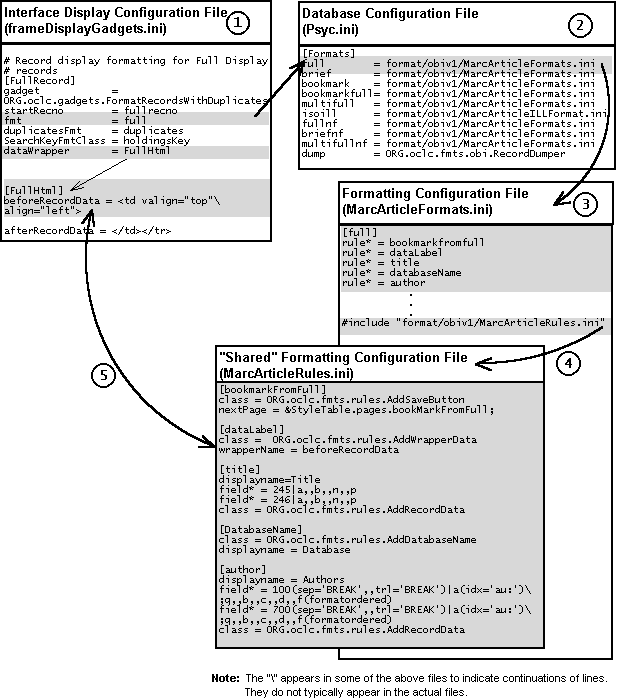
Interface Display Configuration File
An interface display
configuration file is one of the initialization files used to format and
display a record in the WebZ interface. Record
display formatting gadget specifications and data
wrapper specifications are defined in this file. These specifications
are two of several specifications that WebZ uses to build a formatted
display.
Example Interface Display Configuration File
The example below shows the contents of one of the interface display configuration files for the OBI, version 1.
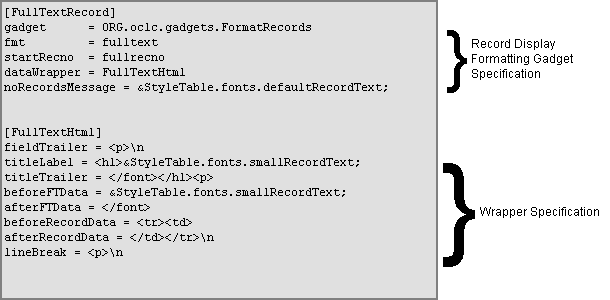
Default Interface Display Configuration Files
Starting with version 4.1.0, two default interface display configuration files are shipped with SiteSearch: One of them is for a frames interface and the other is for non-frames interface. By default, both are declared as parameter values under the InterfacedisplayGadgets section of the JaSSIServer.ini file.
| File Name | Description |
| frameDisplayGadgets.ini | Defines specifications for a frames display interface. |
| noframeDisplayGadgets.ini | Defines specifications for a non-frames display interface. |
Record Display Formatting Gadget Specifications
A record display
formatting gadget specification is a section inside an interface
display configuration file. Its main purpose is to start the formatting
process. Additional parameter values for the actual gadget referenced
in a record display formatting gadget specification may also be used to
further define the gadget's actions during the formatting process. One
of these parameters is fmt, which references a format type defined in
the database configuration file for the
current database.
Syntax
The following table lists the basic syntax and parameters for a record display formatting gadget specification:
|
Element |
Description |
|
[specification name] |
This identifies the section in the interface display configuration file that contains a particular record display formatting specification. |
| gadget |
This gadget begins the formatting process. Note: Some gadgets require additional parameters to be set within a record display format specification. One of these is fmt. (See below.) See the Javadoc for a list of all formatting gadgets and their parameters. |
| fmt | This parameter determines the format that is selected from the database configuration file, which ultimately determines the specific formatting configuration file that is used to create the formatted data string. (See the diagram under Display Formatting Configuration File Flow for an illustration of the relationships among the files.) |
| dataWrapper | This parameter references the name of a wrapper specification defined elsewhere in the interface display configuration file. (See below for a complete explanation of the wrapper specifications.) |
A wrapper specification
defines the html or text that surrounds data to be displayed in the Web
browser. Each element in a WebZ interface has its own wrapper specification
that defines how it is to be presented on the HTML page.
Example from the OBI, version 1
For example, by default the [dataLabel] rule specification for the [brief] format in the MarcArticleFormats.ini file is defined as follows:
|
[dataLabel] |
Given the above rule specification, notice that it references beforeRecordData as the wrapperName, which is ultimately defined under the [briefHtml] section in the interface display configuration file, frameDisplayGadget.ini as:
| beforeRecordData = <td valign="top" align ="left"> |
Based on the current
data wrapper for [dataLabel] (as defined in the above examples), the effect
on the display of data would appear similar to the following:
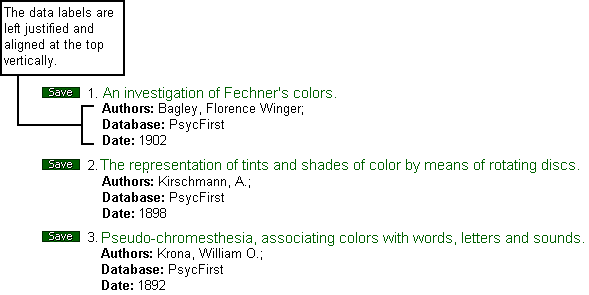
On the other hand, if you were to change the wrapper specification in
the interface display configuration file to align the label to the right,
the specification would look like this:
| beforeRecordData = <td valign="top" align ="right"> |
And, the data labels
would appear right justified as in the following example:
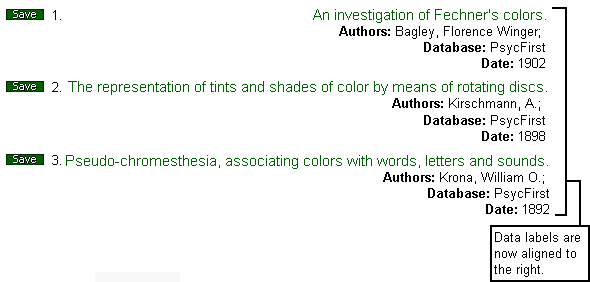
The
Role of Database Configuration Files in Rules-Based Formatting
WebZ rules-based formatting is designed so that each database has its own database configuration file and each database configuration file has its own [Formats] section. The following examples illustrate this design as demonstrated in the OBI, version 1:
Examples of Rules-Based Formatting Design
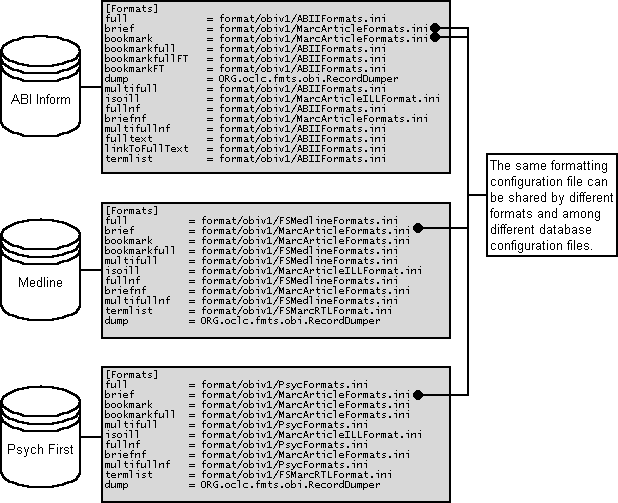
The end result of this construction is that formatting is determined per database. (For more detailed information regarding the [Formats] section and other structures in a database configuration file, see the topic with the same name.)
References to Formatting
Configuration File
Format
types for the current database and their corresponding formatting
configuration files are listed under the [Formats] section in
a database configuration file.
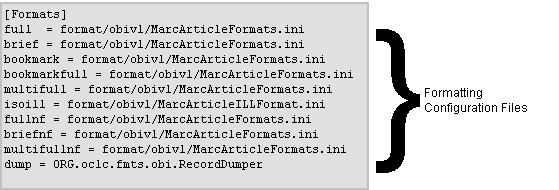
Formatting
configuration files contain the formatting
rules that ultimately create the display string that replaces
the format display gadget entity
on the html page.
See Also
WebZ
Rules-Based Formatting Process Overview
Formatting Configuration Files
JaSSIServer.ini Configuration File